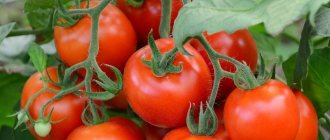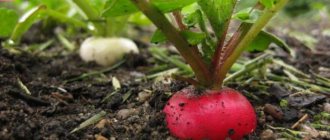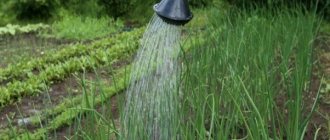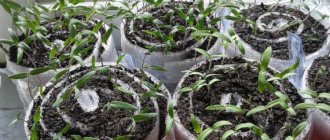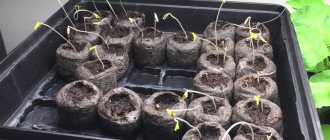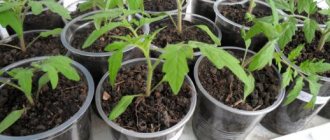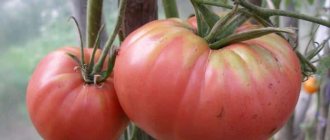Vegetable growing » Tomatoes
2
3137
Article rating
Kira Stoletova
Sowing tomatoes with seeds in open ground is a backup option for cultivating the plant, since it is not always possible to grow seedlings.
Rules for planting tomatoes with seeds in open ground
The method includes almost all the same processes. The difference is that the seeds are immediately sown in a permanent place.
Seedling cultivation of heat-loving crops, including tomatoes, is used in those regions of the country where the duration of the growing season (in other words, the warm period of the year) is less than the growing season of the tomato.
Features of cultivation
For growing tomatoes from seeds in open ground, medium-sized and low-growing varieties are most often chosen. With this method, the resulting tomato bushes in sunlight quickly catch up with plants grown by seedlings. These tomatoes have stronger foliage and an activated immune system. They immediately adapt to exposure to ultraviolet radiation.
Advantages of planting tomatoes in open ground:
- active immune system;
- strong foliage;
- unlimited space for growing the root system;
- no stress from transferring tomatoes into soil from a pot;
- absence of blackleg disease in 100% of cases.
If we talk about disadvantages, then first of all it is low germination , which occurs as a result of lost seeds due to insufficient care, dead from cold and excess moisture, and poor-quality seed material.
Advantages of planting tomatoes in open ground with seeds
- Successful growing is all about getting enough light. Tomatoes grown from seeds will rapidly develop and catch up in growth with their “seedling” counterparts. Their appearance will be much better, the trunk will be stronger, the green mass will be stronger, and planting will take a little time and effort. Tomatoes will quickly get used to ultraviolet rays and become stronger. Their immunity will become stronger and they will not be susceptible to diseases.
- The advantages include unlimited possibilities for the development of the root system. Growing tomatoes with seeds in open ground allows the root system to develop from the moment the first shoots appear.
- Thanks to being kept in open ground, plants are not exposed to stress during transfer from separate containers after diving.
- Tomatoes grown from seeds in open ground are not susceptible to blackleg infection.
Of course, this method has its drawbacks.
- One of the most important disadvantages is the poor level of germination due to poor-quality seed material or improper maintenance conditions.
- Some gardeners consider a delay in fruiting to be a disadvantage. But this criterion is relative. After all, even picking plants can delay plant growth for approximately a week.
- If tomatoes are grown in the middle or northern zone of our country, then you need to choose early ripening and early determinate varieties of tomatoes.
Only under such conditions can you completely bypass the stage of growing seedlings.
Growing tomatoes with seeds in open ground does not require any special skills or abilities. Even beginners can grow tomatoes. The main thing is to know when to plant tomatoes, how to do it correctly, so that sowing seeds is as effective as possible.
Tomato plantation sown with seeds in the ground
- The main advantage is natural sunlight. Such sprouts quickly catch up with indoor seedlings, and look about as stocky, with stronger foliage and high immunity.
- The second important advantage is that the young shoot immediately has unlimited space for roots, and the larger the root, the stronger the plant.
There is also a serious drawback - germination is not very good, so the seeds are planted with a reserve.
If you do not live in the southern region, then you can grow tomatoes from seeds, without the seedling stage, only with early ripening varieties. For such varieties, the first harvest is obtained after 60-70 days from germination. Thus, you can plant seeds not only in the South, but also in the North-West, simply by choosing the appropriate varieties.
When and where to plant tomatoes?
In Russia, tomato seedlings are planted after May 12-14, since at this time there is a minimal threat of unexpected night frosts. It is not worth planting in early spring, since the air and soil are cold, and the tomato seeds will sleep until favorable warm days.
It is necessary to plant in a place that is protected from strong gusts of wind. Plants in open areas often die from frost and sudden cold snaps. The most successful area for planting is the beds where zucchini, pumpkin, cucumbers, legumes and late varieties of cabbage used to grow. You should not plant in the place where there were peppers, tomatoes, potatoes and eggplants.
Important! It is recommended to choose well-lit, open and wind-protected beds; this will help tomatoes grow in large quantities.
Planting tomatoes with seeds
Planting and growing in this way will greatly facilitate your work on the plot of land and save a lot of your time, especially when there is very little free time. You don’t have to take care of the fastidious seedlings for a long time.
Tomatoes planted by seeds tolerate dry weather well and bear fruit before the first frost. Growing tomatoes from seeds allows the plant to get a healthy and strong central root, unlike bushes from ordinary seedlings.
Planting tomatoes using seedlings involves deepening the trunk into the ground. In this way we provoke the appearance of additional roots.
When planting is completed, after some time, we hill up the bushes so that the root system can get stronger. But the slightest lack of moisture in too hot weather can significantly affect the plant and the harvest as a whole.
If tomatoes are planted by seeds, then we can immediately note that the root system of the plant, thanks to this growing method, is initially very strong. This happens due to the fact that we do not have to plant seedlings from container to container.
As we said earlier, you need to stock up on a large number of seeds in order to be on the safe side and carry out effective sowing. After all, no variety has 100% guaranteed germination, no matter how correct the sowing is. Now we need to outline our beds. To do this, we decide what variety of tomato we will plant in open ground - determinate or indeterminate. The distance between bushes and rows will depend on your choice.
- When choosing determinate varieties of tomatoes, the interval between the beds will be about 1 meter, and between the bushes no more than 70 centimeters.
- Holes can be made using a hoe.
- Their depth should be no more than 5 centimeters.
- You need to pour a little superphosphate into each hole and fill it well with water.
- We wait until the water is absorbed and only after that we begin sowing the seeds. They need to be planted closer to the edges, 2 pieces in one place.
- Up to 6 seeds can be sown in one hole; the interval between groups of seeds should be 15 centimeters.
In Russia, tomato seedlings are planted after May 12-14, since at this time there is a minimal threat of unexpected night frosts. It is not worth planting in early spring, since the air and soil are cold, and the tomato seeds will sleep until favorable warm days.
It is necessary to plant in a place that is protected from strong gusts of wind. Plants in open areas often die from frost and sudden cold snaps. The most successful area for planting is the beds where zucchini, pumpkin, cucumbers, legumes and late varieties of cabbage used to grow. You should not plant in the place where there were peppers, tomatoes, potatoes and eggplants.
Important! It is recommended to choose well-lit, open and wind-protected beds; this will help tomatoes grow in large quantities.
To get strong and healthy tomato seedlings, you need to follow a number of simple recommendations.
The sowing procedure must be carried out according to all the rules, and first:
- determine the timing of sowing
- prepare suitable soil and disinfect it;
- choose a suitable container (for initial sowing, for picking);
- process and germinate seeds;
- sow at the required depth and remove to a warm place.
As a rule, the main measures for preparing and processing tomato seeds before sowing include the following:
- disinfect (etch) in a pink solution of potassium permanganate for 20-30 minutes (an old-fashioned and not very effective method), and then rinse under water; or use the more modern and effective drug “Fitosporin”;
- soak in a growth stimulator such as Epin or Zircon (according to instructions).
- germinate in a cloth or on cotton pads.
We invite you to familiarize yourself with: The unique properties of grass and meadow clover
The further development of seedlings depends entirely on proper care.
In order for the seedlings to grow strong, it is worth taking into account the basic conditions of their maintenance and care rules.
As for timing, tomato seedlings are planted only when the threat of the last spring frost has passed and the soil has warmed up sufficiently.
Thus, taking into account all the recommendations for preparing and sowing tomato seeds, as well as following the basic rules for caring for seedlings, you will definitely be able to achieve the desired results and get a generous harvest.
How to prepare the soil for planting?
Experts recommend preparing the soil in the fall . For this purpose, after harvesting the following is added:
- manure;
- ash;
- compost.
The earth must be dug up and left in this form until spring days . This will allow her to become saturated with nutrients during the winter. Half a month before planting, the soil is loosened and watered with plenty of water. Some gardeners cover it with plastic wrap, which helps warm it up. When preparation has not been carried out for one reason or another, you can plant the seeds in open ground in holes.
Preparation of seed material
Tomato seeds must be pickled and hardened. In the first case, they are soaked in a solution of potassium permanganate for 15 minutes. Hardening is carried out as follows - the seeds are wrapped in cloth folded in 3 layers and placed in the refrigerator where the vegetables are stored for 1-2 days. This approach allows you to speed up the germination of plants.
You can also plant dry or germinated seeds . In order for them to sprout, they are placed on a bandage or gauze folded in 3 layers. After this, leave in a warm place at a temperature of +26°C...+28°C. You need to make sure that the fabric is not dry. After the petioles appear, the seeds can be planted.
Preparing tomato seeds
Seeds must be prepared before planting. To do this, certain procedures are carried out.
Sorting
For planting, you should use only high-quality seeds. To select good ones, they are kept for 15 minutes in a salt solution (30g of salt per 1 liter). Those seeds that float to the surface are empty and should be thrown away. Those that are at the bottom are suitable for sowing.
Disinfection
Tomato seeds are disinfected using one of the proposed solutions:
- 1 g of potassium permanganate is diluted in 100 ml of water.
- Phytosporin (1.5 g of the drug per 100 ml of water), soak the seeds for 2 hours.
- Dissolve 10 g of baking soda in 1 liter of water. Leave the seeds in the soda solution for 12-24 hours.
- Aloe juice is diluted with water in a ratio of 1:1. The seeds are kept in the solution for 24 hours.
Boric acid solution (optional)
Necessary for feeding seeds and destroying pathogenic bacteria. 1 g of the substance is diluted in 1 liter of water. The seeds are kept for a day.
Growth stimulant
Sodium Humate, Epin, Potassium Humate or Epin are suitable. It is diluted in melt water and the seeds are treated for 12 hours.
Epin-Extra or Zircon: 1-2 drops of the product are dissolved in 100 ml of water. Seeds in gauze are immersed in a solution at a temperature of +20C for 12-20 hours.
Hardening (not required)
For hardening, soaked seeds are left in the refrigerator for 24 hours. This treatment makes the seedlings strong and resistant to unfavorable growing conditions.
Care
After refrigeration, the seed is laid out between layers of a damp cloth on a saucer. The cloth should be regularly moistened with warm water. The seeds will hatch in 4-5 days, then they can be sown.
How to sow correctly?
There are several basic schemes for planting tomato seeds in open ground:
Tape . It is suitable for large areas. For it, they dig a trench 30 cm deep. Small holes are made in it, the distance between which should be 30-40 cm. If tall tomatoes are planted, then they should be located 90 cm from each other. For small bushes, 80 cm is enough. This method saves land and creates convenient conditions for watering with a drip system and a hose.
- Square nest . This scheme is suitable for bushy tomato varieties. The minimum distance between specimens is 50 cm, and between squares – 80 cm. This placement makes it possible to create comfortable conditions when cultivating the soil, watering and harvesting.
- Chess . Seeds are planted in a trench on both sides in a checkerboard pattern. This method allows you to arrange the planting, saving space.
- Tape nesting . A ribbon is formed from the trench, and seeds are planted on both sides at once. The distance between the trenches should be large - at least 1.5 m. The distance between the bushes is 20-30 cm. This scheme is economical and suitable for small bushes.
Initial care
After the seeds are planted in open ground, it is recommended to make a small greenhouse. To do this, arches of rigid wire are stuck into the ground, over which a film is placed, secured around the perimeter with bricks. Sowing tomatoes should be ventilated at least once a day, preferably during the day, so that the temperature difference is not high.
Attention! After the first shoots have appeared or if there is a risk of return frosts at night, lutrasil is placed on top of the greenhouse. This should only be done at night. After the temperature has reached +20°С…+23°С, the greenhouse is removed.
Watering and fertilizing
The most optimal watering option is twice a day for seven days . In some cases, once is enough, but it must be plentiful so that the plant stores water for the next seven days. Irrigation efficiency is influenced by a number of factors. First of all, this is a type of watering at the root. This option is necessary in order to saturate the plant with the necessary moisture and at the same time maintain air humidity at the proper level.
Watering can also be done along the furrows, the main thing being that the drops do not fall on the leaves. This is due to the fact that they turn into lenses and the sun's rays burn the plant.
The soil should be moistened moderately - do not allow it to dry out and do not overwater it . It is ideal if the water is at room temperature or rainwater.
The first root feeding is done 2-3 weeks after germination. It is liquid and is prepared from 5 grams of potassium sulfate and 50 grams of simple superphosphate per 1 bucket of water. Until this time, the seeds have enough substances that are in the soil. Then the fertilizer application schedule is drawn up so that the plant receives 3-4 feedings over the entire growing season. If the soil is poor, then their number can be increased.
Yeast can be used as a top dressing : 1 kg of yeast is used for 5 liters of warm water. The mass is infused for 24 hours, after which half of the liquid is diluted with the same part of water.
As a second feeding, spraying or foliar feeding with urea is used. To prepare it, dilute 5 grams of fertilizer in a bucket of water. Also add a little potassium permanganate to the solution so that the liquid has a slightly pinkish tint.
The next feeding is complex. You can use one of the following options:
- any ready-made complex fertilizer with nitrogen;
- yeast feeding;
- 1 tbsp. nitrophoska for 1 bucket of water;
- 0.5 liters of chicken or 1 liter of cow manure with 2 tbsp of ash and 20 grams of superphosphate.
Temperature
Tomatoes are one of the most heat-loving crops, so at temperatures:
- +14°С…+16°С – germination begins and seedlings form;
- +25°С…+30°С – seedlings are actively germinating;
- + 10°С – growth stops;
- below +12°C and above + 30°C – flowering stops, the ovaries fall off;
- up to +5°C and more than +43°C – the plant is quickly damaged and dies;
- below +0.5°C – tomatoes die instantly.
In open ground, healthy tomatoes grow that have dense foliage and a powerful, well-developed root system. But to get a rich harvest, you need to make an effort - properly prepare the soil, create all the necessary conditions for the development of the plant.
Sowing tomato seeds for seedlings
There are general recommendations for sowing tomatoes. Place the substrate for seedlings in a planting container. You will need to compact it a little. We moisten it sufficiently, but do not fill it. The seeds are placed at a not very deep depth, about 0.5 cm. You can make a hole or groove with a convenient object and place the seed there. It is advisable to germinate it first. Next, the seed is lightly sprinkled with soil, moistened again from above (it is convenient to do this from a spray bottle) and the container is placed in a bag or under glass.
The bag will retain the required moisture. Also, seeds require lighting 10-12 hours a day. If the daylight hours have not yet reached the required length, take care of providing your future seedlings with fluorescent lamps or special LED lamps for plants.
Growing temperature is within 20-24 degrees.
Sowing tomatoes in a common container
Tomatoes do well in group plantings. Therefore, many gardeners sow them in one large container. This is especially true when you need to get a large number of seedlings.
The general container is filled with soil, which needs to be moderately moistened. The seeds are arranged in a chaotic manner and are slightly buried with a toothpick into the damp soil. And lightly sprinkle with soil on top. A bag or film is placed over the container to create a greenhouse, and the dishes are placed in a warm, bright place. Under lamps or on a windowsill without drafts.
When shoots appear, we remove the package. If you plant already sprouted seeds, shoots will appear earlier than when we plant unsprouted ones.
This is the simplest and easiest way.
Here's also a more streamlined version of the overall fit. Here, even depressions and grooves were made in the moistened soil, and the seeds were placed at the same distance. Sprinkled and also placed under the bag. In this case, the shoots also appear in even rows.
It is convenient to do general plantings of plants of the same variety in a separate container so that they do not mix with other varieties.
Below is an example of sowing ultra low-growing cherry tomatoes:
But in essence, whether we sow evenly or chaotically, the result is the same, the general plantings will still need to be picked after the appearance of 2 true leaves. To ensure that the plants do not interfere with each other and develop well, you will need to place them in an individual container.
Remember that it is important for us to get strong seedlings with a good root system. The longer the plants sit together, the sooner they begin to compete for light and soil for their roots, this inevitably leads to stretching and weakening of the seedlings. Therefore, it is important to make a pick in a timely manner (see below for more information).
In the meantime, let's look at sowing methods that do not require picking.
Sowing tomatoes in individual containers
And there is also always the option of individual planting directly into separate containers. It is suitable for those who do not want to deal with picking seedlings and have a lot of space for individual dishes.
These can be seedling cassettes. Just put the soil into the cassette recesses, compact it slightly and moisten it. Using a pencil or stick, make a 0.5 cm depression in the soil. Place the seed in the hole and cover it with soil. Place the seed cassette in a bag and place it in a bright, warm place. When shoots appear, remove the bag.
Peat or coconut tablets. Tablets usually already contain a ready-made substrate in a compressed and dehydrogenated form. To restore them, you need to fill the tablets with hot water at 90 degrees. This will help disinfect the substrate and at the same time saturate it with water.
The tablet will straighten and swell. You need to wait until the tablets have cooled completely before sowing.
Further steps are as follows: in the center of the tablet, use a convenient object to make a small depression, half a centimeter deep. Place tomato seed in it. Cover it with soil from the sides. As a rule, plastic greenhouse containers with a transparent lid are included with the tablets.
You need to close the lid and place the container with tablets under the lamps or on a warm windowsill. When shoots appear, the lid is removed.
Peat or plastic pots. Sowing occurs in exactly the same way as in the case of sowing with cassettes or peat tablets, discussed above. Remember to create a greenhouse using a container with a transparent lid or a regular transparent bag and remove it as soon as the first green loop hatches.
Seedlings planted individually can only be transferred to a larger volume in time, when the roots fill the entire substrate allocated to them. During transshipment, the addition of vermicompost or well-rotted compost is welcome.

